By Matt Wolfe
During the last half century, Detroit has been the place that many manufactures choose to debut their latest concept vehicles. The global visibility of the North American International Auto Show gives automakers ample exposure to show off their latest dream cars to the media and the public. These are some of our favorite concepts that made their mark in the Motor City.
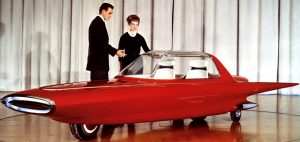
The Gyron was an idea that could have only come from the mind of Alex Tremulis. Tremulis was a man of two great obsessions; aerodynamics and gyroscopes. The Gyron represented a merger of those fixations. By creating a sleek two-wheeled car that was internally balanced by way of a gyroscope, Tremulis felt he had created the ultimate form of aerodynamic transportation. The Gyron debuted at the Detroit Auto Show in 1961, and was then displayed at the Ford Rotunda building. Sadly, the car was destroyed in the 1962 Rotunda fire. Tremulis would continue his pursuit of aerodynamic perfection through experiments like the Gyronaught X-1 land-speed record car.
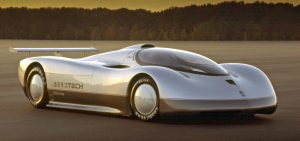
The Oldsmobile Aerotech cars were a series of experimental vehicles built between 1987 and 1992, with the first Aerotech making its appearance at the 1987 Detroit show. That car was later driven by A.J. Foyt on a closed course to a speed record of 257 mph. The car actually topped 263 mph over a rolling mile. True to its name, the Aerotech was designed to be exceptionally aerodynamic, with adjustable underbody sections to control the distribution of downforce. Early versions were powered by a turbocharged Oldsmobile “Quad 4” engine while later iterations would receive the 4.0 liter “Aurora” V8.
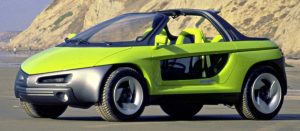
The Stinger encapsulated Pontiac’s desire to capitalize on the interest in the booming SUV market during the late 1980’s. The Stinger looked like a life size hot-wheel coated in neon green paint. Behind the Stinger’s extroverted exterior there were enough features to make a Bentley owner jealous, including two cellular phones, a CD player with a detachable AM/FM stereo, a drink cooler mounted in the doors, tool case, first aid kit, flashlight, extension cord, two dust busters, a camping table, biking bags, and even a garden hose. While the Stinger was never truly meant for production, it was an active lifestyle vehicle that could have been very well received at a time when small SUV’s were just coming into their own.
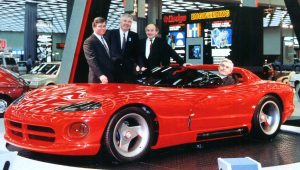
The Viper was initially unveiled as a concept car in 1989. Bob Lutz, who was then head of Global Product Development for Chrysler, wanted to build a car that would put some excitement back into a brand that spent most of the last decade building K cars. Lutz had Chrysler designer Tom Gale sketch a modern interpretation of what a Chrysler-built Cobra might look like. The result was a car that looked so venomous, the name Viper came naturally. With the help of fellow Chrysler executive Francois Castaing and a dedicated team of engineers, the Viper went from concept to complete in less than two years and made a second debut in Detroit in 1992, but this time, as a production car.
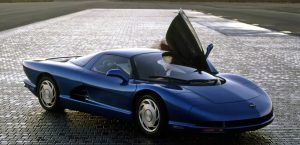
The CERV III was the latest in a long line of experimental mid-engine prototypes from GM when it appeared at the NAIAS in 1990. GM had toyed with the idea of a mid-engine Corvette numerous times throughout its history. Legendary GM engineer Zora Arkus-Duntov championed the mid-engine layout as early as 1960 when he built the CERV I prototype car that he lapped GM’s Milford proving grounds in at 206 mph. The CERV III was an evolution of Duntov’s concept. Equipped with a twin-turbocharged V-8, four-wheel drive, active suspension, and four-wheel steering, the CERV III was a rolling science experiment that showed GM had the potential to turn the Corvette into a true Ferrari fighter.
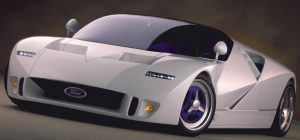
The GT90 was a design exercise built to rekindle memories of Ford’s four straight Le Mans victories during the 1960’s. It showcased Ford’s “New Edge” design language that was established by then global Vice President of Design Jack Telnack. Under its modern skin was an engine worthy of the GT name; an all-aluminum V12 saddled with four Garrett turbochargers capable of producing over 700 horsepower. The GT90 could hit 100 mph in 6.2 seconds on its way to a top speed of over 230 mph. Though the GT90 was never meant for production, it was an incredible example of engineering that paved the way for later iterations of Ford’s legendary supercar.
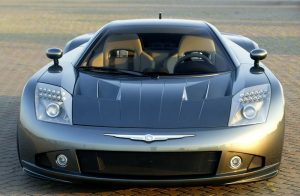
Chrysler debuted this two door mid-engine concept car in 2004. Powered by a 6.0-liter AMG-designed V12 producing 850 hp, the Four-Twelve was more powerful than any Hellcat Charger or Challenger. Utilizing Chrysler’s contemporary art deco styling language, the car looked closer to production ready than concept car dream. The Four-Twelve’s technical specs were impressive; zero to 100 mph in 6.2 seconds, dual-control-arm front and rear suspension with stainless steel pushrods and adjustable shocks, and a curb weight of less than 2800 lbs. Sadly, any hope of producing the Four-Twelve was lost in 2005 due to concerns over production costs.
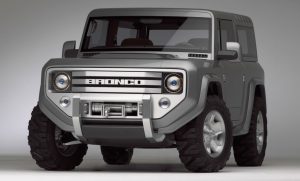
Ford Bronco Concept.
2004 Ford Bronco
Since the Bronco’s departure in 1996, rumors of its return have been continually circulated. Ford teased the public at the 2004 NAIAS with this Bronco concept vehicle. It’s taught dimensions, sharp lines, and retro flair captivated many in attendance and generated hope that Ford might bring back the legendary nameplate. Equipped with a 2 liter diesel engine, an intelligent 4WD system, and a six-seed manual transmission, this Bronco could have become Ford’s answer to the Jeep Wrangler. However, the introduction of the new Ford Escape sealed this Bronco’s fate as a fantasy four-wheeler.
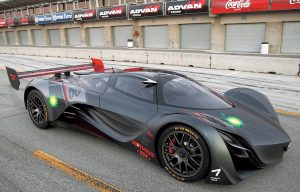
Similar to Ford’s GT90, the Mazda Furai was built as a design exercise to demonstrate their “Nagare” design language. Also like the GT90, the Furai was as fast as it looked. Power came courtesy of a mid-mounted Renesis 3 rotor engine producing 450 hp. Weighing in at a feathery 1500 lbs, the Furai was a lightweight machine with a heavyweight punch. It wore the number 55 in reverence of Mazda’s 1991 24 Hours of Le Mans-winning ancestor, the 787B. A fully functional car, the Furai and was tested at various racetracks before it caught fire during a Top Gear magazine photoshoot in 2008. To this day, no one knows what became of the Furai’s scorched remains.

Toyota rolled out this stunning concept coupe at the 2014 North American International Auto Show. The car was the company’s take on a high performance sports car and drew inspiration from past Toyota legends like the 2000GT and MR2. The concept was said to be a front-engine, rear wheel drive car but no other technical specifications were given. Many thought of the FT-1 as the successor to the legendary Supra, and enthusiasts clamored for Toyota to make a production version. Though details of the FT-1’s potential arrival have been scarce ever since its debut, reports have surfaced indicating that Toyota has been continuing development of the car jointly with BMW.